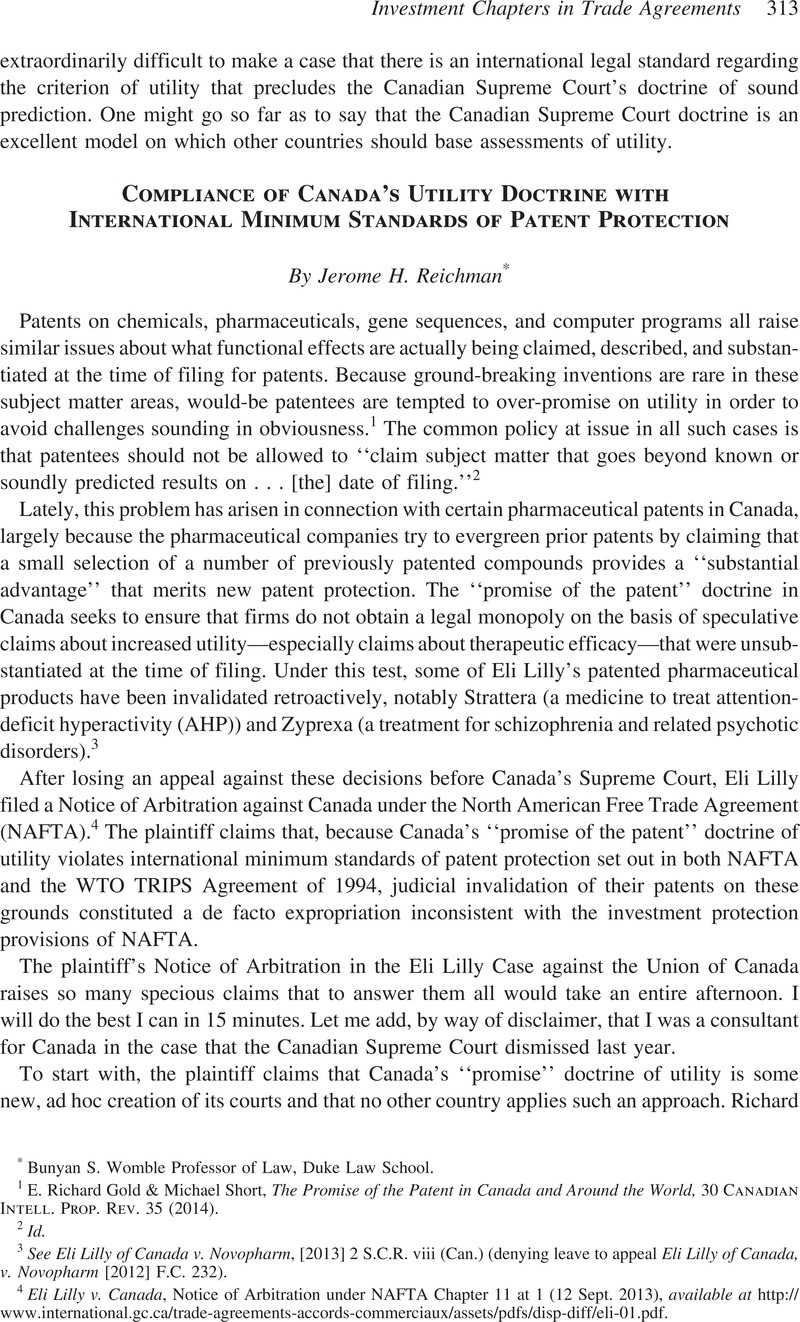Article contents
Compliance of Canada’s Utility Doctrine with International Minimum Standards of Patent Protection
Published online by Cambridge University Press: 20 January 2017
Abstract

- Type
- Investment Chapters in Trade Agreements: Intellectual Property Rights as Protected Investments
- Information
- Copyright
- Copyright © American Society of International Law 2015
References
1 Gold, E. Richard & Short, Michael, The Promise of the Patent in Canada and Around the World, 30 Canadian Intell. Prop. Rev. 35 (2014)Google Scholar.
2 Id.
3 See Eli Lilly of Canada v. Novopharm, [2013] 2 S.C.R. viii (Can.) (denying leave to appeal Eli Lilly of Canada, v. Novopharm [2012] F.C. 232).
4 Eli Lilly v. Canada, Notice of Arbitration under NAFTA Chapter 11 at 1 (12 Sept. 2013), available at http://www.international.gc.ca/trade-agreements-accords-commerciaux/assets/pdfs/disp-diff/eli-01.pdf.
5 Gold & Short, supra note 1, at 44.
6 The Patent (Amendment) Act, 2005, No 15 sec. 3(d), Acts of Parliament 2005 (India).
7 Agreement on Trade Related Aspects of Intellectual Property Rights, Apr. 15, 1994, Marrakesh Agreement Establishing the World Trade Organization, Annex 1C, art. 27, para. 1, 1869 U.N.T.S. 299; 33 I.L.M. 1197 (1994).
8 Gold & Short, supra note 1.
9 See Manual Pat. Examining P. § 2107.01(A).
10 See, e.g., Assoc. for Molecular Pathology v. Myriad Genetics, 133 S. Ct. 2107 (2013) (holding that a patent for synthetic composite DNA (cDNA) isolated in the laboratory was invalid since the segments of DNA occurred in nature before they were isolated).
11 Reichman, Jerome H. & Dreyfus, Rochelle Cooper, Harmonization Without Consensus: Critical Reflections on Drafting a Substantive Patent Law Treaty, 57 Duke L.J. 85 (2007)Google Scholar.
12 WTO Appellate Body, India—Patent Protection for Pharmaceutical and Agricultural Chemical Products (1997) WT/DS/50/AB/R, paras. 47–48; See Reichman, Jerome H., Securing Compliance with the TRIPS Agreement After U.S. v. India, 4 J. Int’l Econ. L. 588 (1998)Google Scholar. See further Reichman & Dreyfus, supra note 11.
13 See further Yu, Peter K., The Objectives and Principles of the TRIPS Agreement, 46 Houston L. Rev. 979 (2009)Google Scholar.
14 See World Trade Organization, Ministerial Declaration of 14 November 2001, WT/MIN(01)/DEC/1, 41 I.L.M. 746 (2006)Google Scholar (referredto as the “Doha Rounds”), available at http://www.wto.org/english/thewto_e/minist_e/min01_e/mindecl_e.htm; See generally Abbott, Frederick M. & Reichman, Jerome H., The Doha Round’s Public Health Legacy Under the Amended TRIPS Provisions, 10 J. Int’l Econ. L. 921 (2007)CrossRefGoogle Scholar.
15 On this issue, see the Max Planck Declaration on Principles of International Patent Protection (Apr. 2014), at http://www.mpg.de/8132986/Patent-Declaration.pdf, signed by some fifty or more distinguished law professors from all major countries and continents.
16 See Reichman & Dreyfus, supra note 11.
17 See, e.g., Reichman, Jerome H., Intellectual Property in the Twenty-First Century: Will the Developing Countries Lead or Follow?, 46 Houston L. Rev. 1115 (2009)Google ScholarPubMed.
- 1
- Cited by




